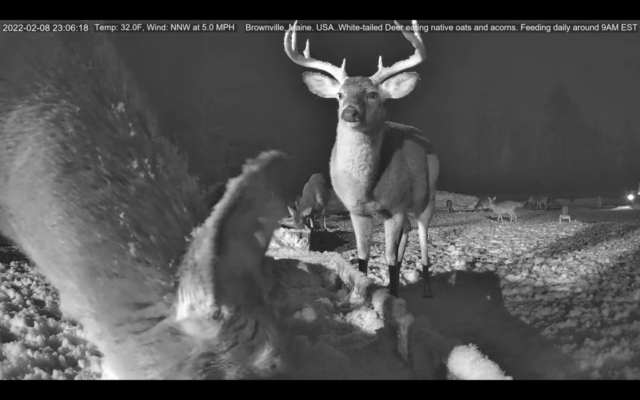
Brownville man’s deer-feeding venture keeps growing, but experts don’t recommend his methods
BROWNVILLE — Richard McMahon drives down a snowy hill and onto the field below, the crate on the back of his ATV packed with oats. He calls it the “oatmobile.”
Deer scatter across the land, their white tails bobbing. Others stay near, carefully watching as McMahon fills the eight wooden troughs with oats, apples and acorns.
Once the area clears and is quiet again, they come out to nibble, happily unaware of the webcams streaming their activity to thousands of viewers on Facebook and YouTube.
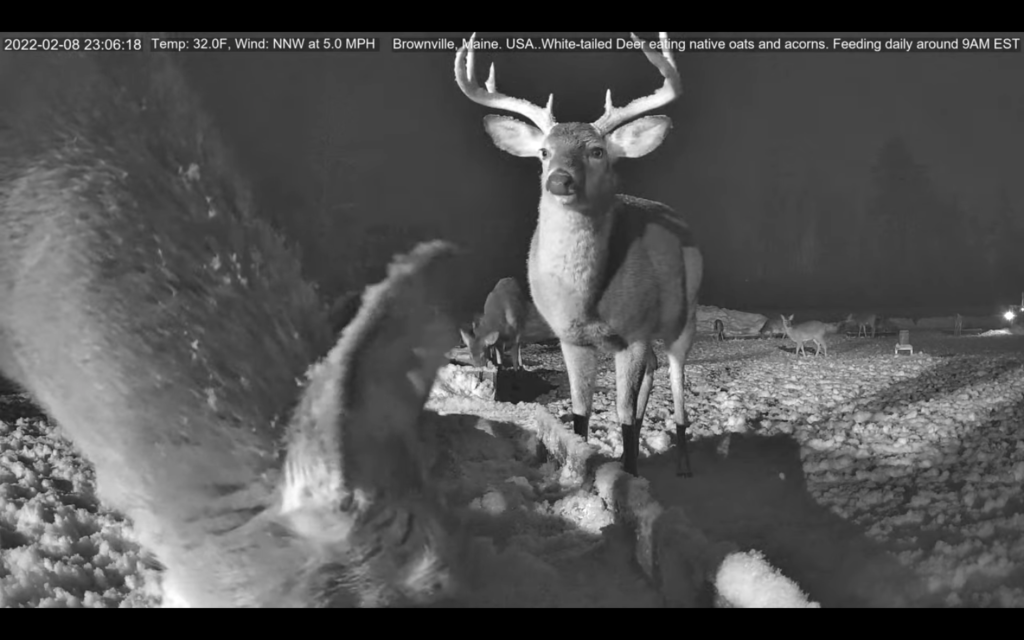
LIVE VIEW – A live webcam captures white-tailed deer feeding in the evening at Richard McMahon’s property in Brownville. Sometimes the deer gaze directly into the camera, like this big buck.
McMahon, 75, runs the nonprofit Brownville’s Food Pantry for Deer. Feeding the animals that have had to adapt to shrinking habitats and increased predation by coyotes is his contribution to the world, he said. But his passion conflicts with biologists who don’t recommend feeding Maine’s deer foods they don’t typically eat in their natural habitat, even as they recognize the activity is legal from mid-December through May.
If someone is insistent, the Maine Department of Inland Fisheries and Wildlife has recommendations for minimizing harm, deer specialist Nathan Bieber said.
Bieber thinks McMahon’s deer-feeding pantry is the largest endeavor of this kind in the state, where deer are fed in a concentrated area, he said. Organizations such as the Aroostook County Conservation Association serve in a more educational capacity and encourage growing food plots to supplement the deer’s usual fare, but it’s a very different program, Bieber said.
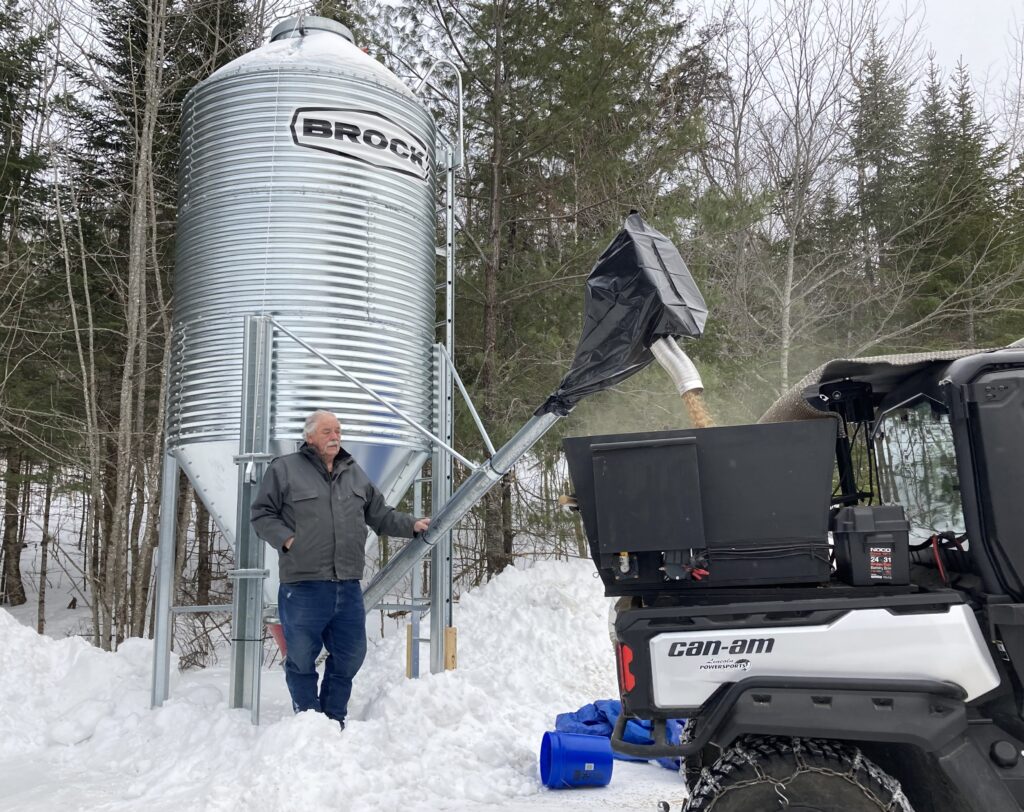
DEER FEED – Richard McMahon pours oats from the silo into the crate of his ATV in Brownville on Feb. 2. He’ll then drive the vehicle around his property and fill troughs with the oats, along with apples and acorns, so area white-tailed deer can feast.
“I grew up on deer meat,” said McMahon, who also used to hunt. “We didn’t go to the local grocery store. We got our own meat. It’s my turn to give back. Instead of eating, I’m feeding.”
McMahon remembers feeding deer as a 7-year-old in Peekskill, New York, and the fascination has stuck with him. He has casually fed deer during different points in his life, but his effort in Brownville began about 13 years ago.
Sometime in 2017, he posted footage of his hoofed friends munching online. Supportive messages flooded the comments section on Facebook and YouTube, and the effort has attracted viewers from 119 countries, he said.
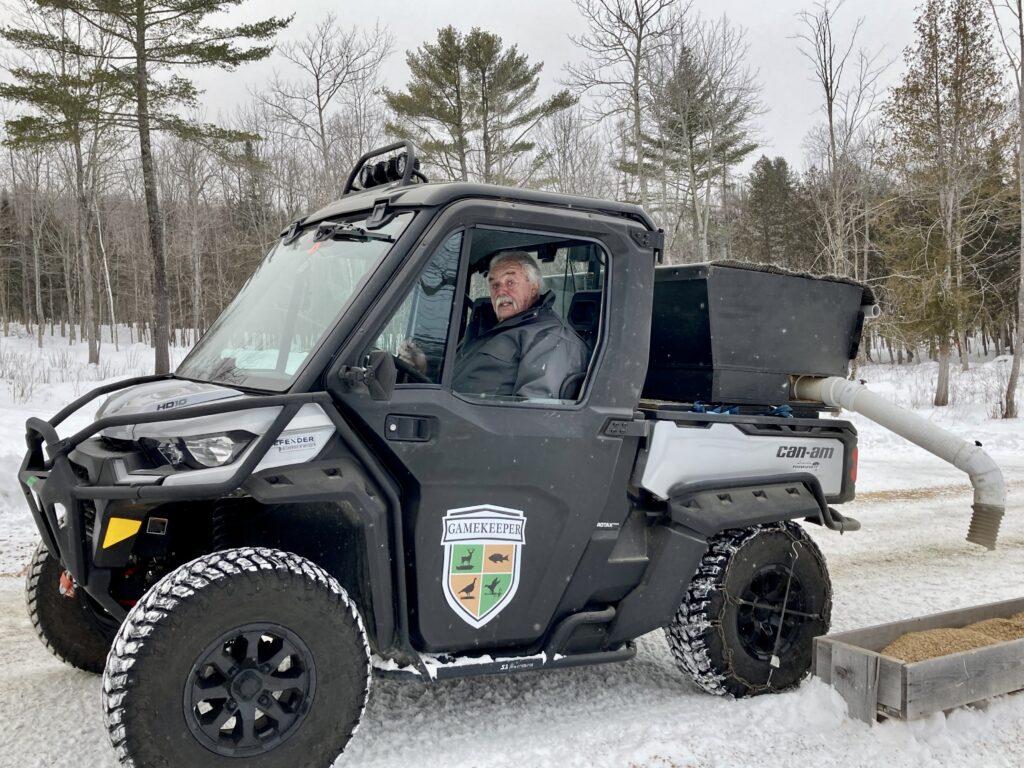
FEED BY ATV – Richard McMahon slowly drives his ATV around his property, stopping at each wooden trough and filling it with oats for the deer on Feb. 2. The back of the ATV contains oats, which travel through a spout into the feeding stations.
McMahon receives phone calls, letters and comments on social media about people’s fascination with the deer-feeding pantry. They feel a sense of calm when watching the deer, he said. Some have even told him it helps lower their blood pressure.
McMahon’s hobby evolved into a nonprofit about two years ago when he realized he was spending too much on deer feed and needed some help. Now donations completely cover the costs, he said.
About a decade ago, McMahon was feeding area deer 150 or so pounds of oats daily. The operation grew and grew, and he now puts out about 700 pounds of feed every day, he said.
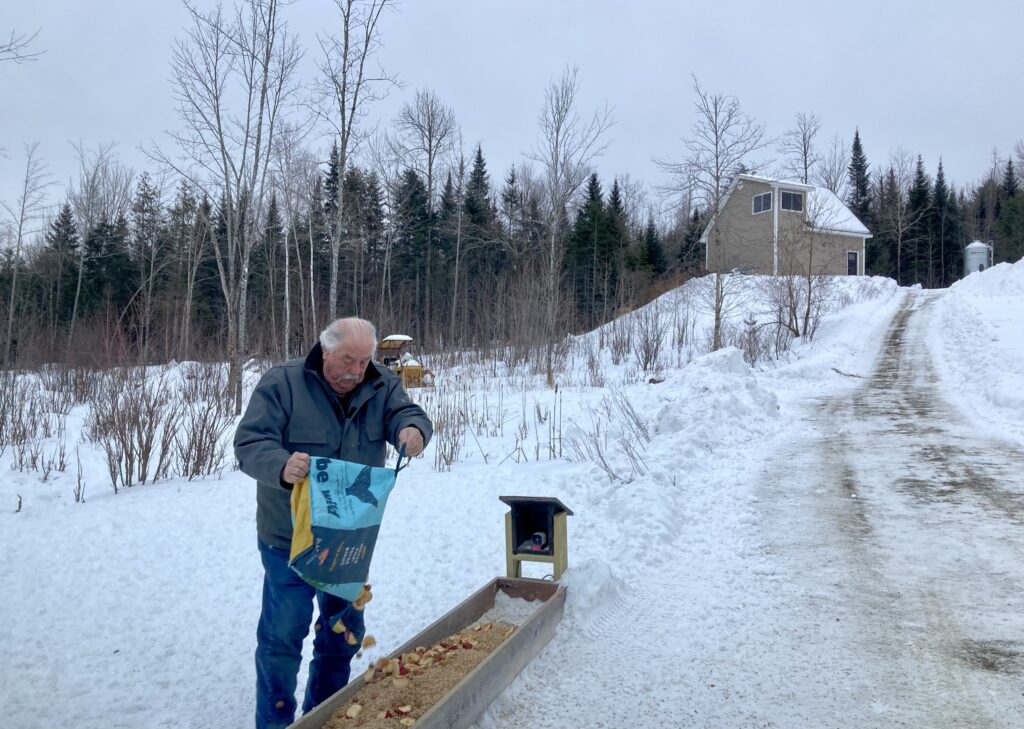
APPLE TROUGHS – Richard McMahon adds apples to the wooden troughs already filled with oats for the deer in Brownville on Feb. 2.
McMahon purchases the oats from Agri-Cal Inc. in Houlton, which delivers it in a huge truck and empties it into the silo on his property. He buys reserves from Three Rivers Hardware in Milo and Bob’s Farm Home & Garden in Dover-Foxcroft.
As the number of deer McMahon’s property attracts and the amount of feed has increased, so has the cost to maintain the pantry. He predicts this year will cost about $9,000. That’s excluding the 48 three-pound bags of apples that he buys from Tradewinds Market in Milo each week, which costs about $143, he said.
It is illegal to feed deer in Maine from June 1 to Dec. 15, during which several months coincide with the state’s deer hunting season. The rest of the year, it’s allowed, though not encouraged by experts.
If someone is going to feed deer, they should provide the animals with more of what they’re used to eating, Bieber said. Foods such as oats and alfalfa hay should be introduced slowly and in small amounts that are increased gradually to help build tolerance, he said.
“Deer break down food quite a bit differently than people do,” Bieber said. “They require lead-up time with new foods to get the microbial community in their guts ready to digest the new food.”
Although feed such as oats and pelleted foods formulated for deer certainly work, Bieber recommends a more natural approach. Dropping hardwood tree tops for the deer to reach buds that may be too high, along with providing apples and acorns, would be better. These are foods deer are already accustomed to eating, he said.
McMahon said he has watched over the years as more deer suffer from their habitats being destroyed. Feeding the deer, especially during harsh winters, has to be more helpful than harmful, he said.
“My fulfillment is the peace of mind,” he said. “They’re not going into a spring pregnant and starving to death. They’re healthy and ready to go.”
While the lack of quality wintering habitats due to industrial activity is very real, it’s an issue most critical in northern and western Maine and parts of Down East, Bieber said. That’s where deer density is declining.
The DIF&W views the deer population in southern and central Maine, including Brownville, as stable or slightly increasing, Bieber said. Deer in these areas tend to live pretty well on their fat reserves in the winter, though supplemental feeding – executed in a way to mitigate risks – can be beneficial when a severe winter strikes, he said.
Legislation passed in 2021 has allowed the department to begin purchasing land this year, which will be managed to protect deer wintering areas.
If someone is thinking about feeding deer during seasons when it’s legal, Bieber suggested contacting DIF&W for guidance. He created a “Small Woodlot Owner’s Guide” that encourages more natural practices that don’t rely on artificial feed.
McMahon thinks he’ll set up a trust in the future. He imagines his son Randy, vice president of the nonprofit, will continue the legacy.
“It’s just loving wildlife and seeing what’s happened to these guys over the decades,” he said. “They need a helping hand, and they get it here.”